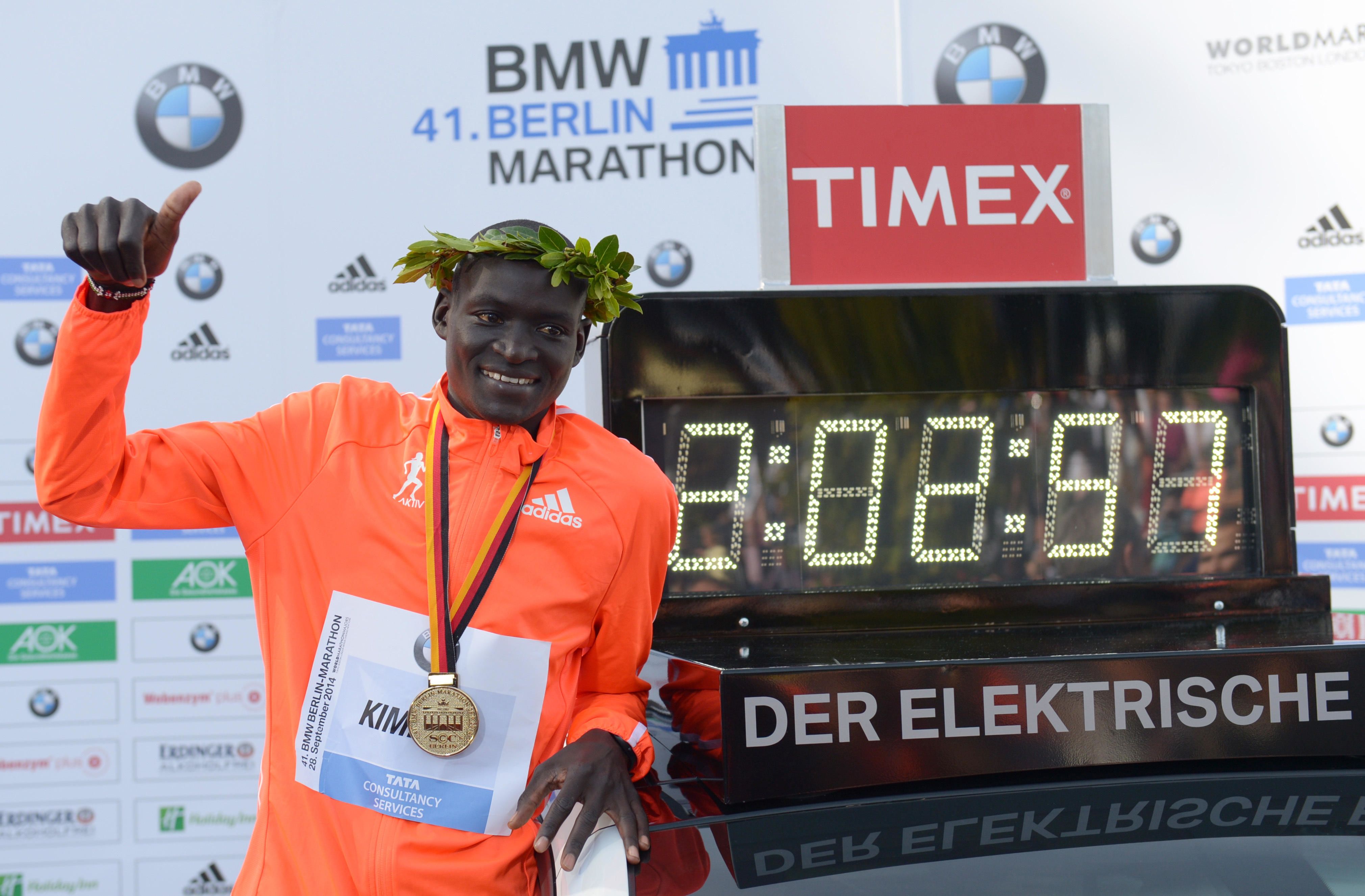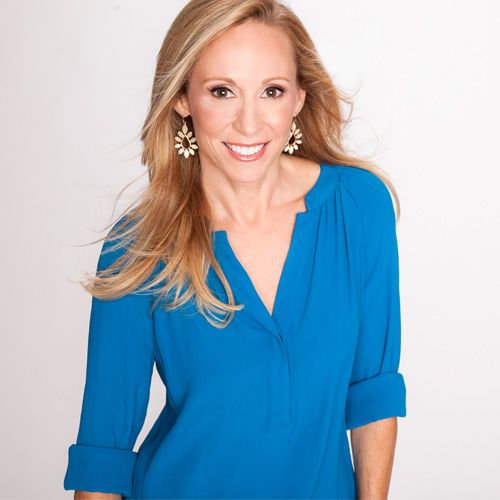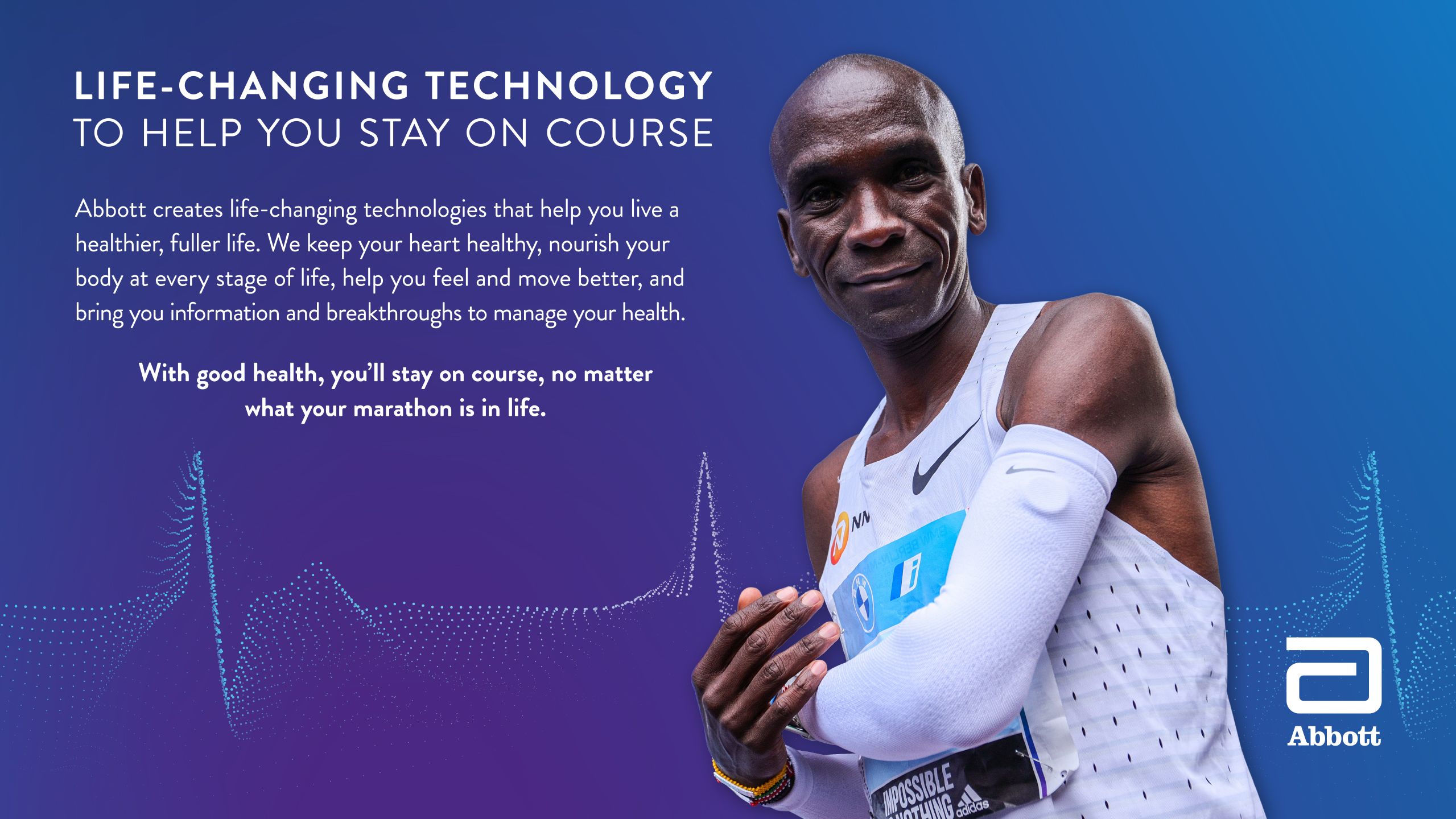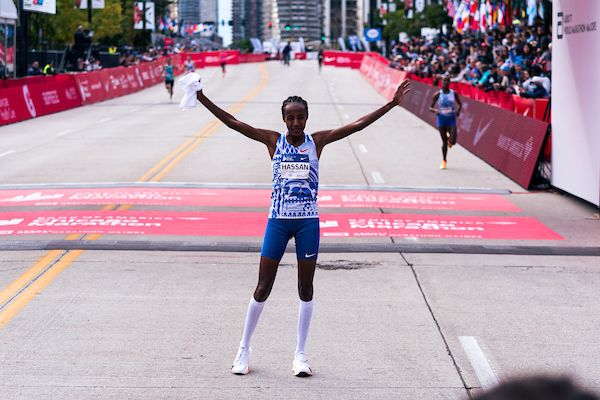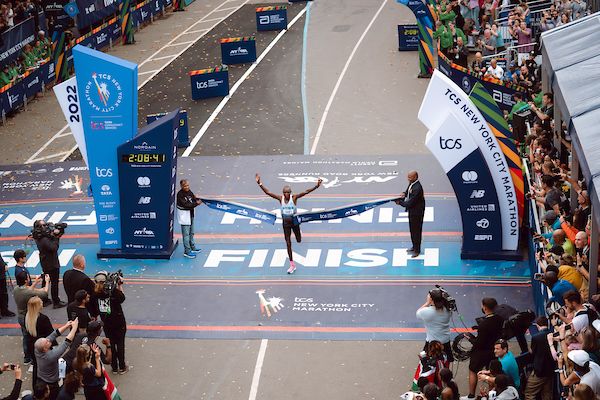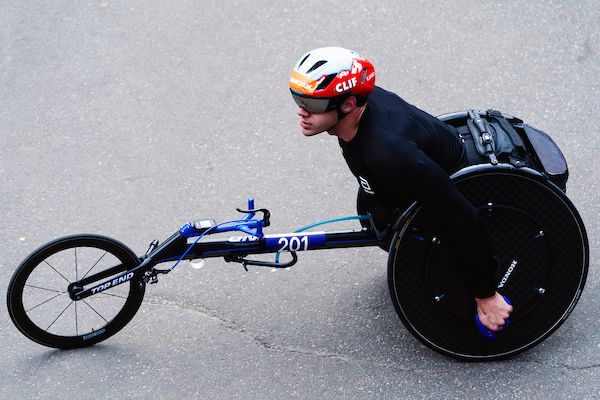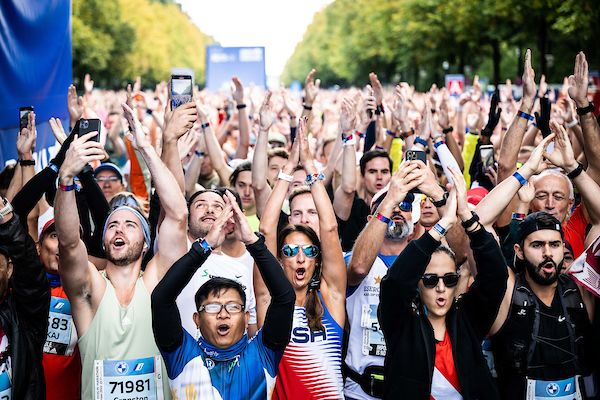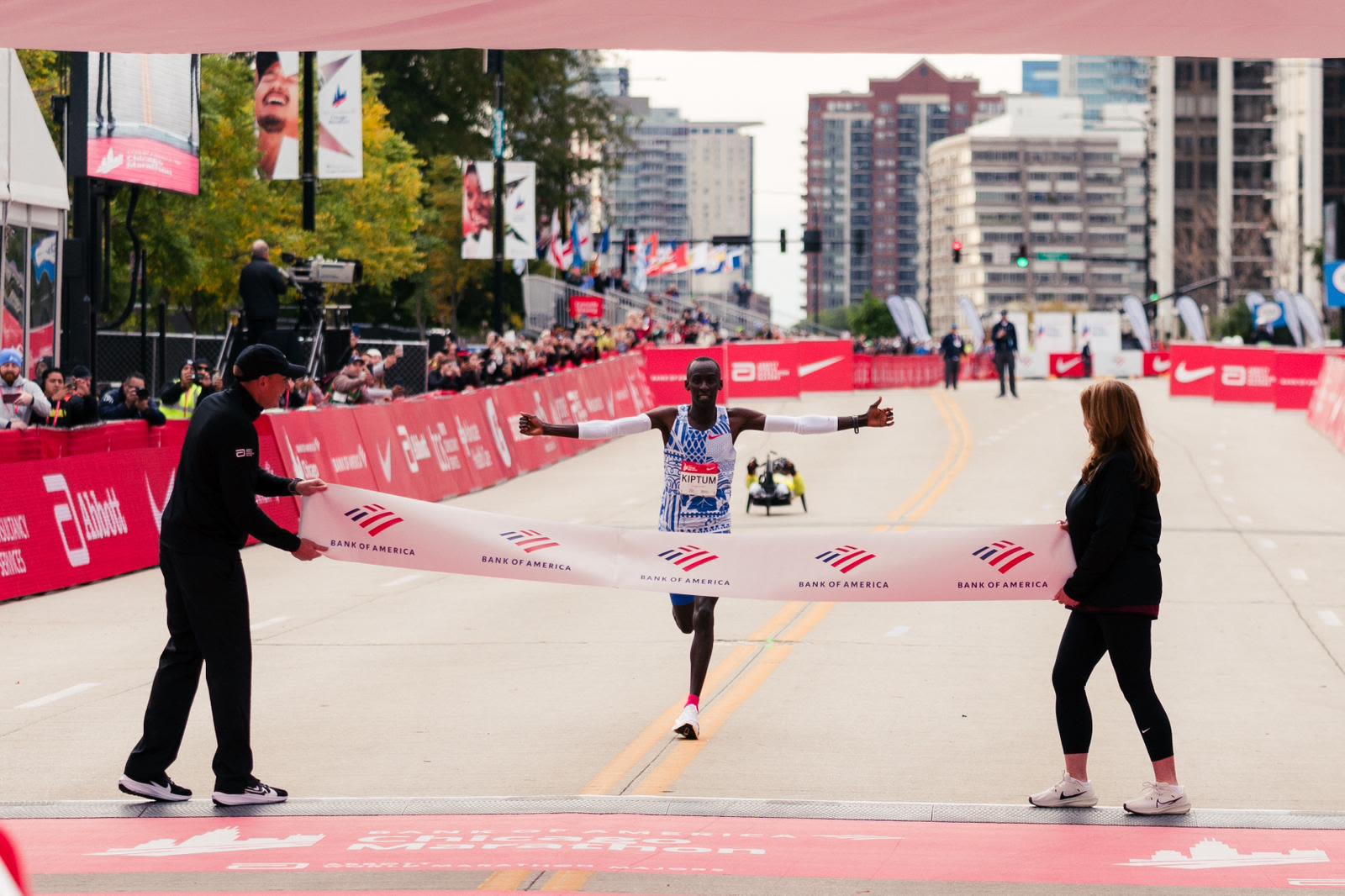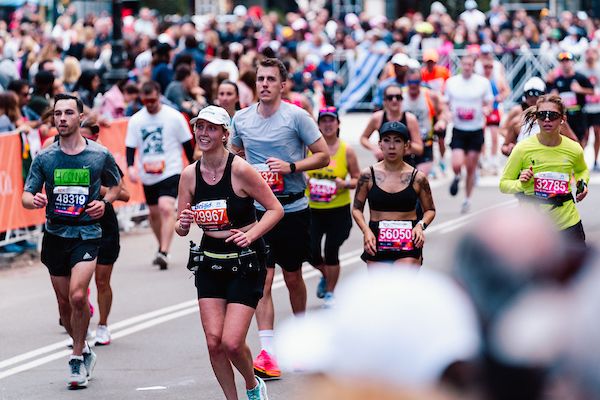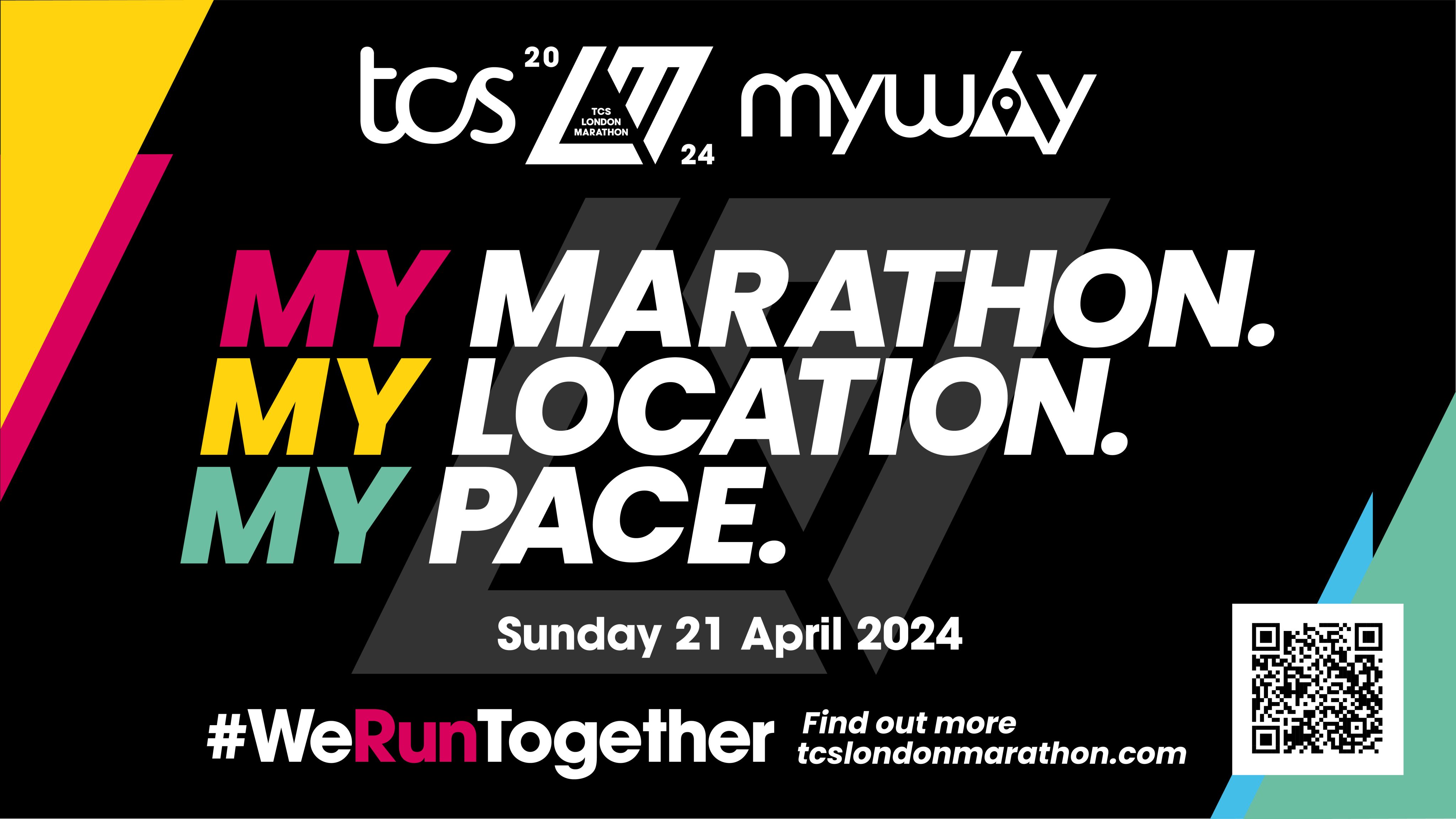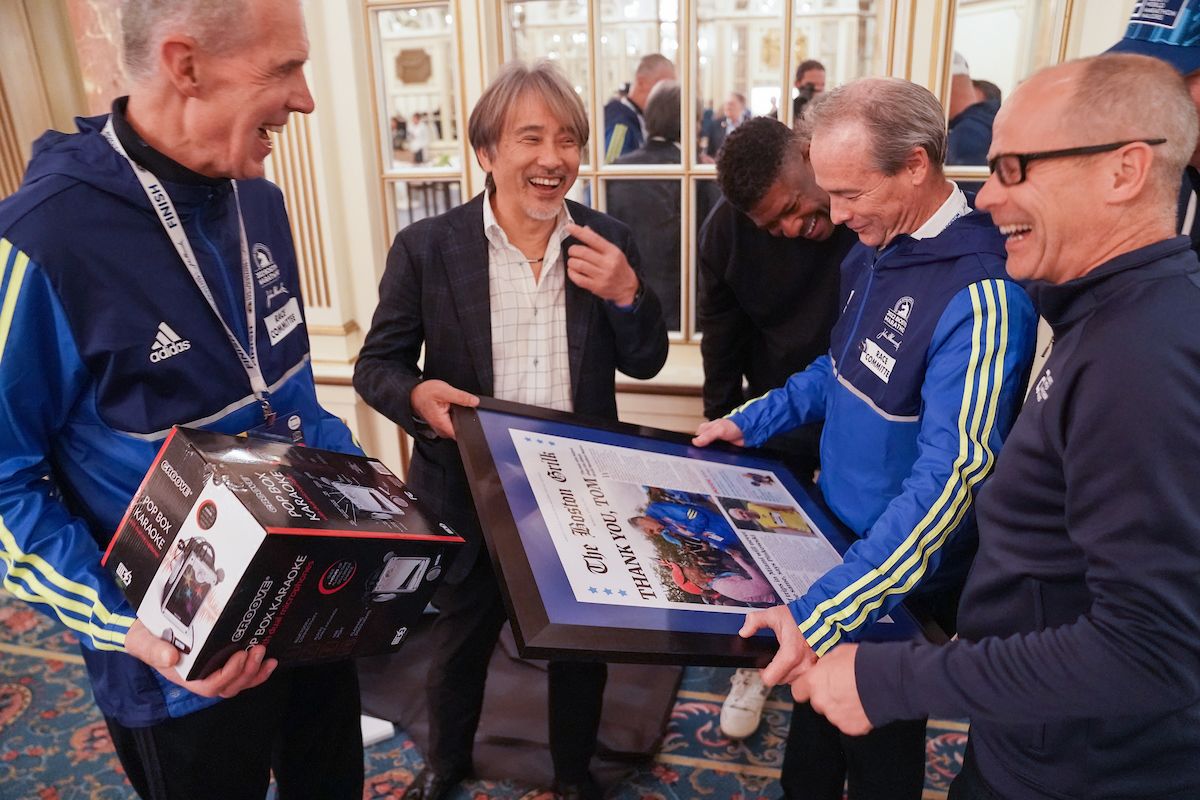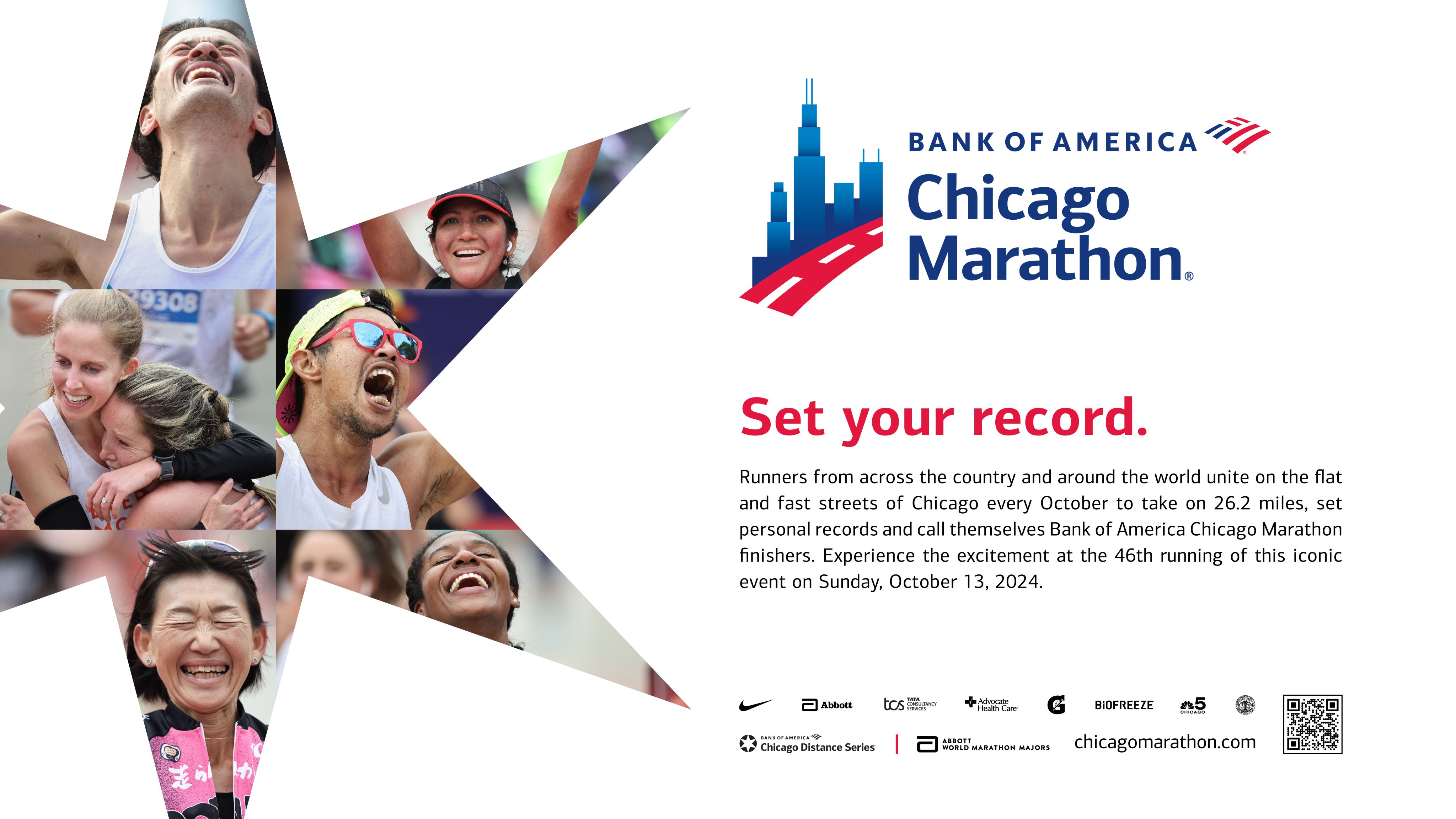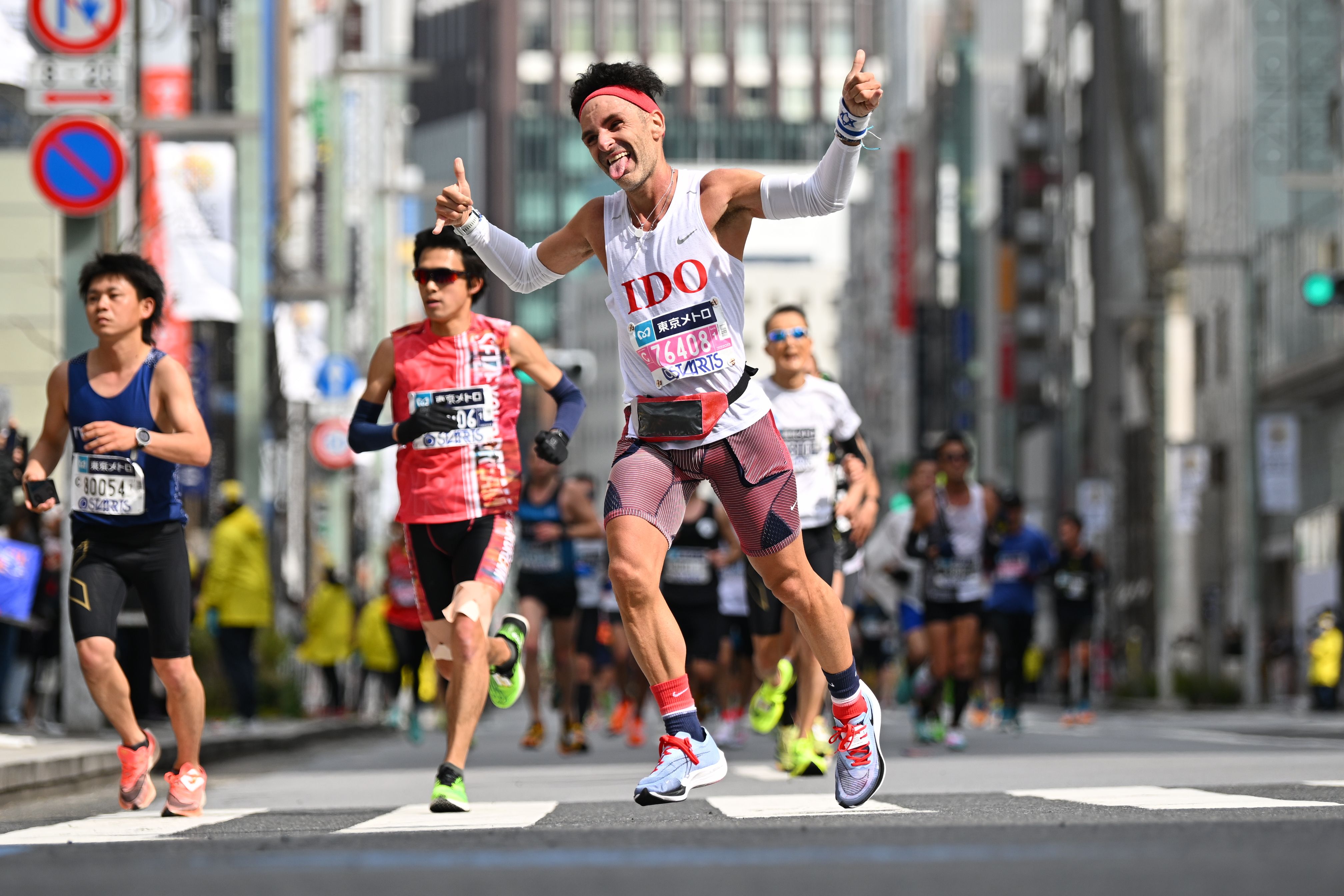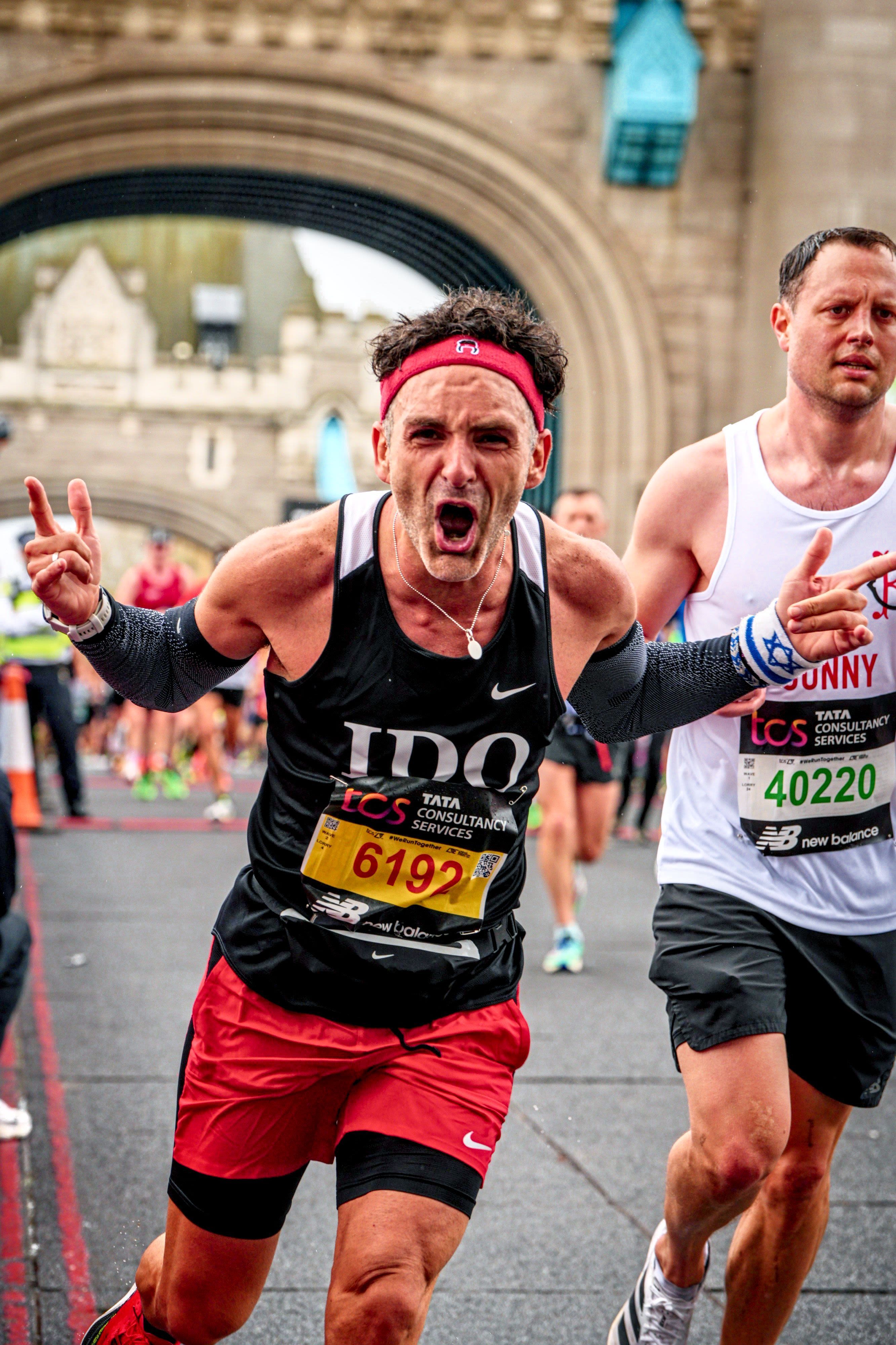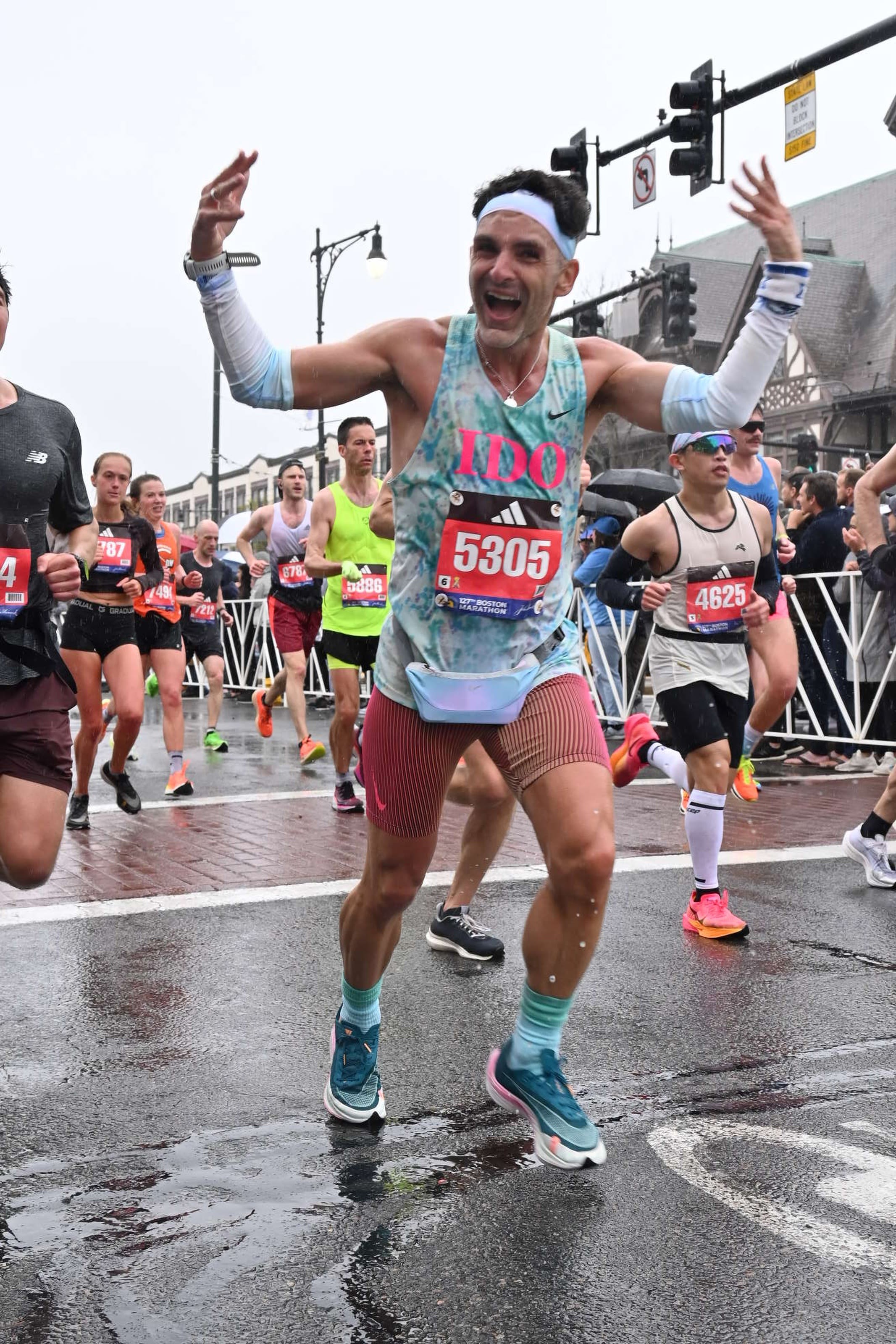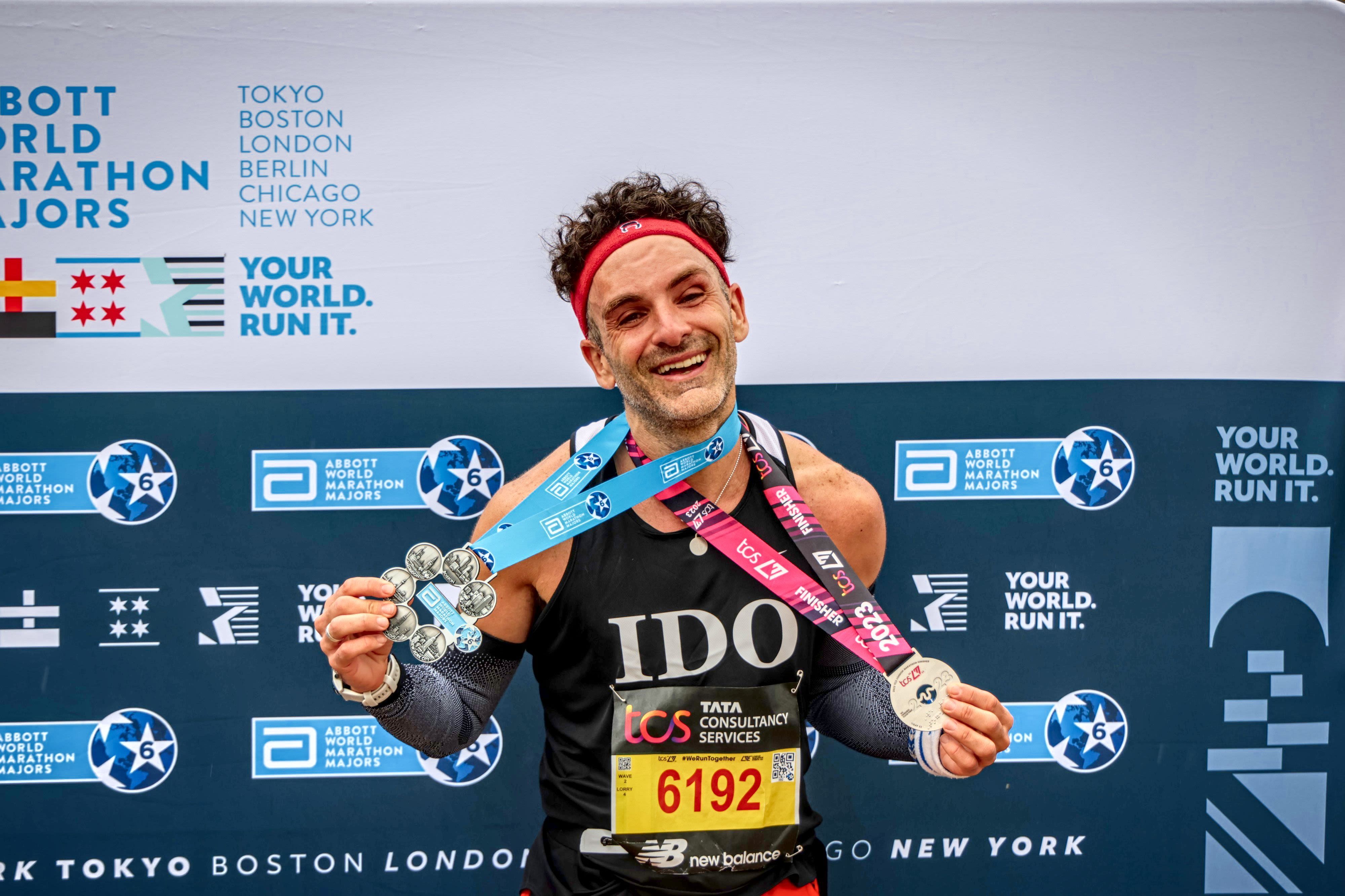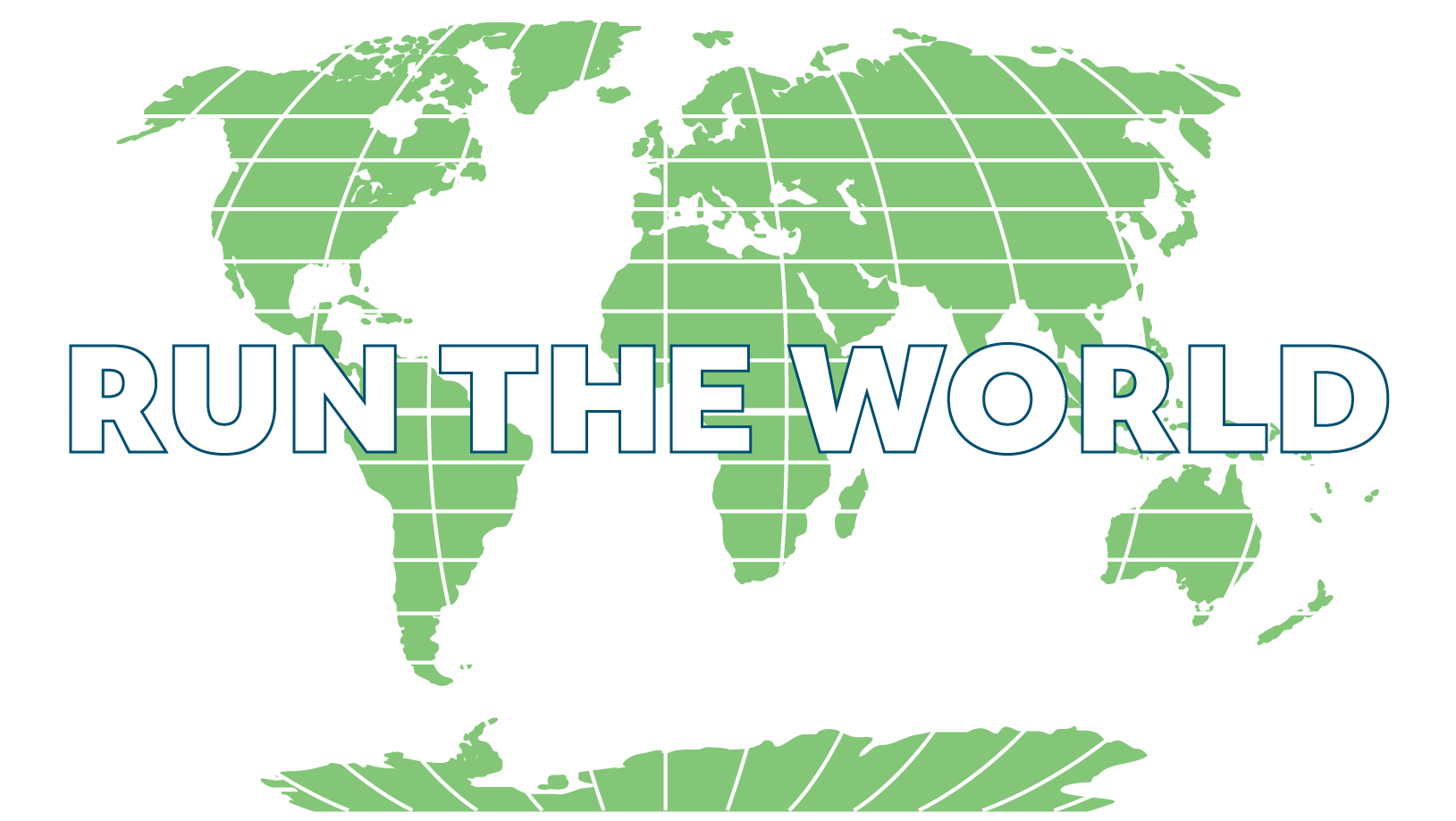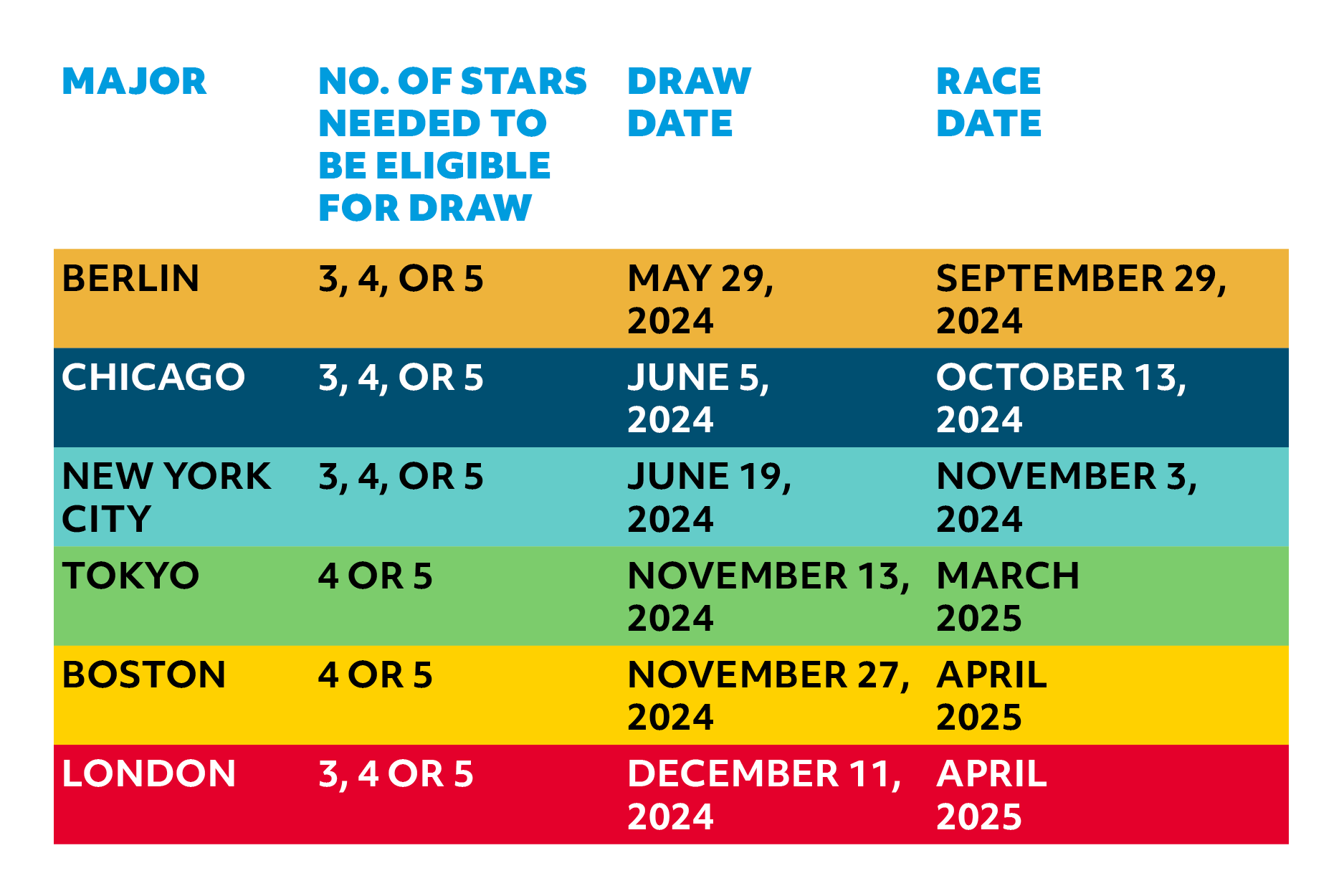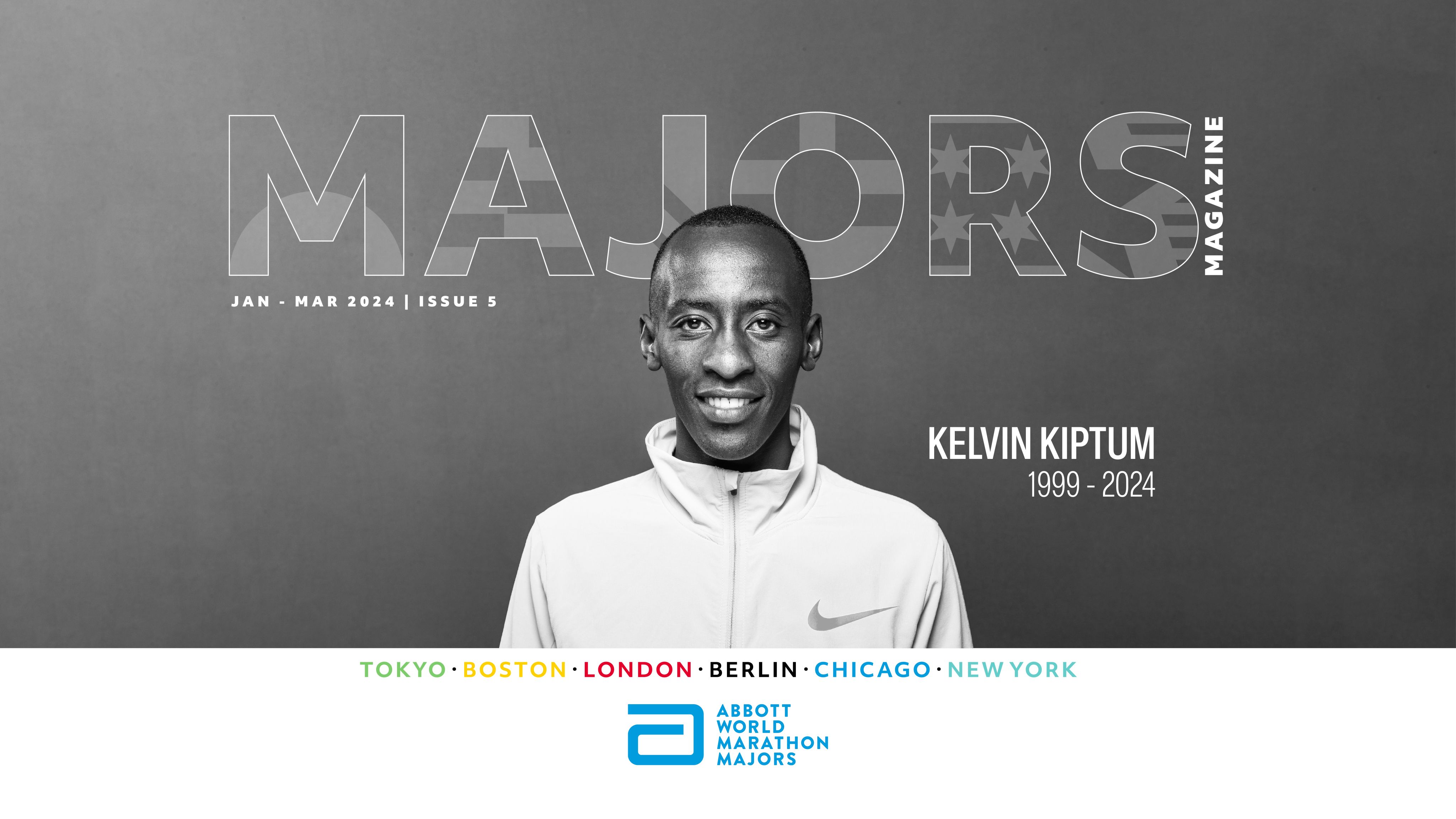
We look ahead to the beginning of another AbbottWMM season with mixed feelings.
The excitement and anticipation of the racing to come and stories to unfold are as strong as ever, especially in the context of an Olympic year.
But those sentiments are accompanied by a sadness that our entire community felt when the news of Kelvin Kiptum’s tragic passing broke.
At just 24 years old, he had run only three marathons, and yet was already in the vanguard of a revolution in the distance.
None of us will forget where we were when he stopped the clock in Chicago at 2:00:35.
Kelvin and his coach Gervais were lost to their families and the wider running world at a time when they had barely given us a glimmer of the heights they could have reached.
Events such as this give us all a reminder of the fleeting nature of our time here.
At AbbottWMM, our mission is to inspire the world through marathons. Through his incredible feats on the roads of Valencia, London and Chicago, Kelvin Kiptum did exactly that. There have been tributes from all quarters, and there are more in this special edition of MAJORS.
Above all, I would like to think, as we look ahead to a year full of promise, that each of you will take inspiration from one of the true greats and apply it to your efforts as you strive for your goals. More importantly, I hope you have the opportunity to pass that inspiration on to others around you too.
I can’t think of a better legacy than that to have been left by the fastest marathoner in history.
Dawna Stone, CEO, Abbott World Marathon Majors
The Image
The day after he smashed the world record in Chicago, Kelvin Kiptum was all smiles as he posed infront of the the city that had roared him home.
(Kevin Morris for Bank of America Chicago Marathon)
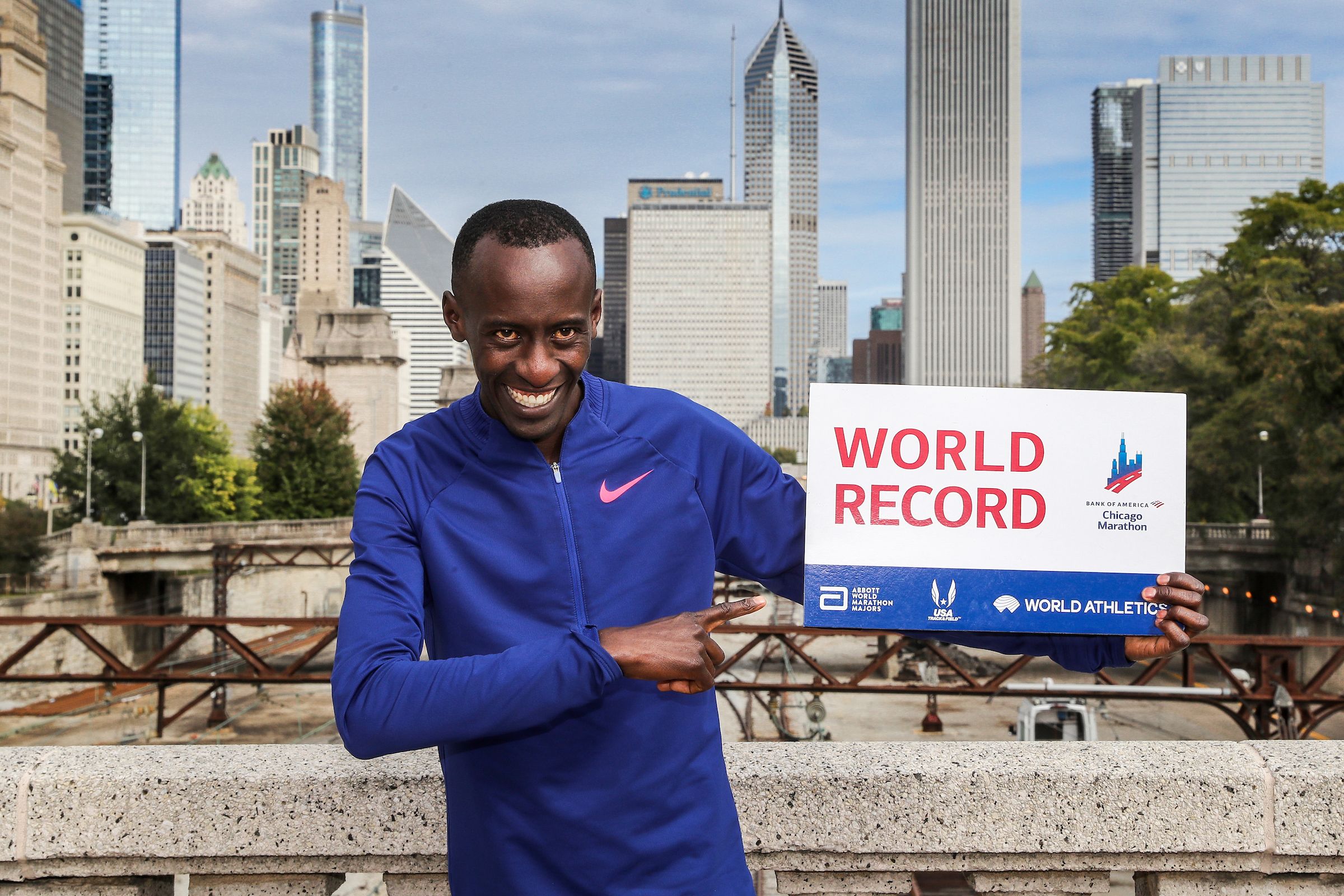

The Image
The moment Kelvin Kiptum became the world's fastest man. Chicago, 2023.
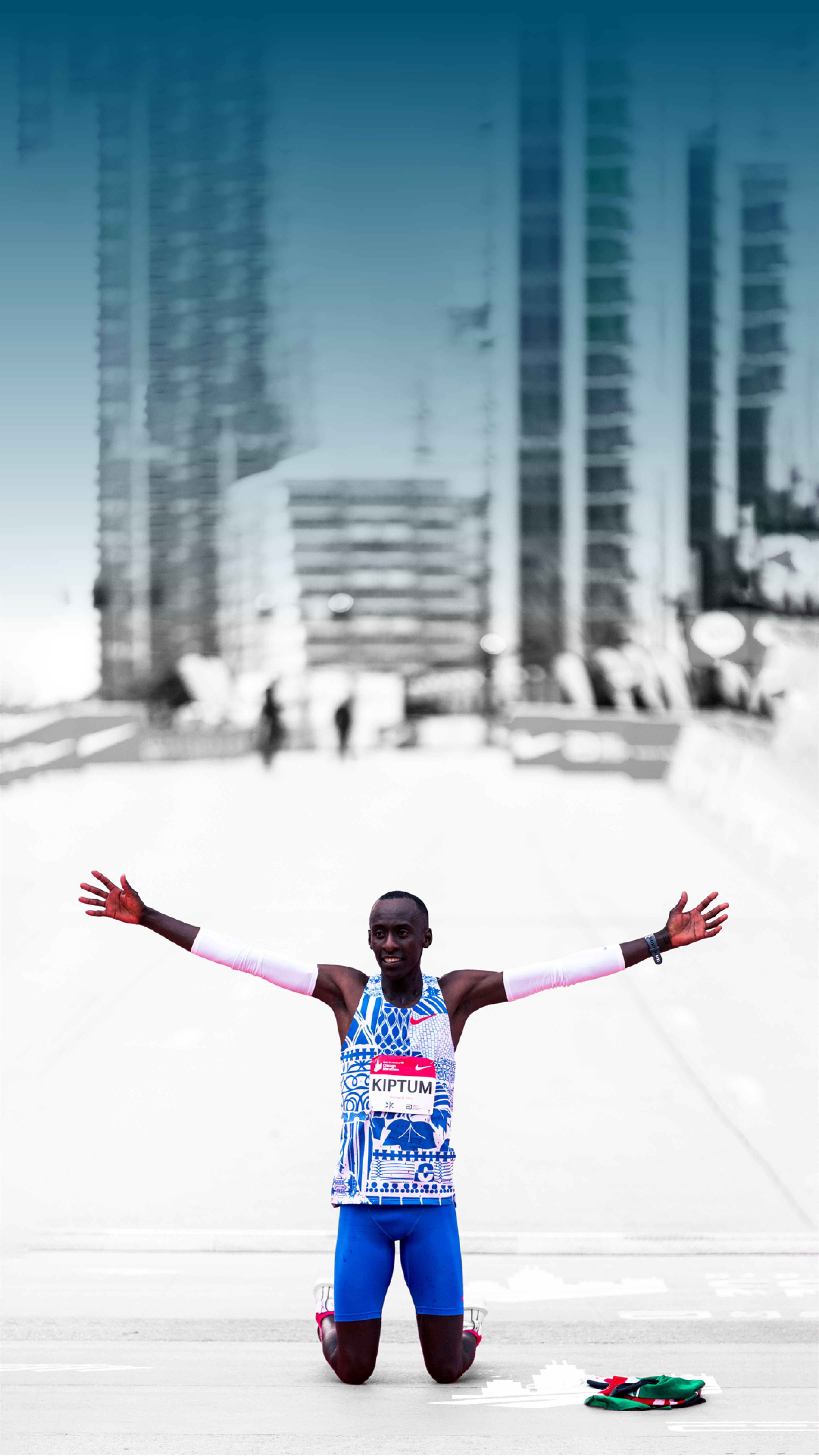
THE WARMUP
HASSAN AND KIPCHOGE READY FOR TOKYO
Sifan Hassan and Eliud Kipchoge will headline the field for the 2024 Tokyo Marathon.
Hassan, the reigning AbbottWMM Women's series champion, will be targeting her third different Majors win in as many races, while Kipchoge returns to the race where he set the course record in of 2:02:40 in 2022.
Kipchoge also has fond memories of Olympic Gold in the city in 2021.
CHEBET EYES THREE-PEAT IN BOSTON
Kenya's Evans Chebet will line up to attempt a hat-trick of wins at the 2024 Boston Marathon in April.
Chebet upset the odds last year when he beat Eliud Kipchoge to claim his second straight victory on Boylston Street in April.
He is joined by fellow Kenyan Hellen Obiri, who also returns to the city to defend the title she won in 2022. Obiri also won in New York City in 2023.
LONDON OFFERS EQUAL PRIZE MONEY
The 2024 TCS London Marathon will make history as the first Major to offer equal prize money in the open and wheelchair divisions.
An additional $54,500 in 2024 means the total prize pot stands at $308,000, creating parity with the non-disabled athletes.
All winners in the elite races will receive $55,000, with the runner-up earning $30,000 and third-place $22,500.
CHARITY PLACES REMAIN FOR BERLIN 2024
The lottery results for the BMW BERLIN-MARATHON are now out. If you were unlucky in the draw, there are other ways to secure your spot in the 50th anniversary edition of the race.
Charities and tour operators still have spots available, - see here for more information.
There will also be the AbbottWMM draw for 250 places in the race in May 2024.
KIPTUM'S CHICAGO RECORD RATIFIED
Just days before the desperately sad news of the death of Kelvin Kiptum, the 24-year-old's world record set at the 2023 Bank of America Chicago Marathon was ratified by World Athletics.
Kiptum ran 2:00:35 on an historic day in the Windy City that will never be forgotten.
There are more tributes to his career and legacy later in this issue of MAJORS.
NEW YORK ENTRIES OPEN FOR 2024
The entry process for the 2024 TCS New York City Marathon is underway.
Runners seeking to secure a place through the Guaranteed Entry pathway have until March 21 to do so.
Applications for Non-guaranteed entries will open on February 28.
The 2023 edition of the event was the largest marathon in the world that year.
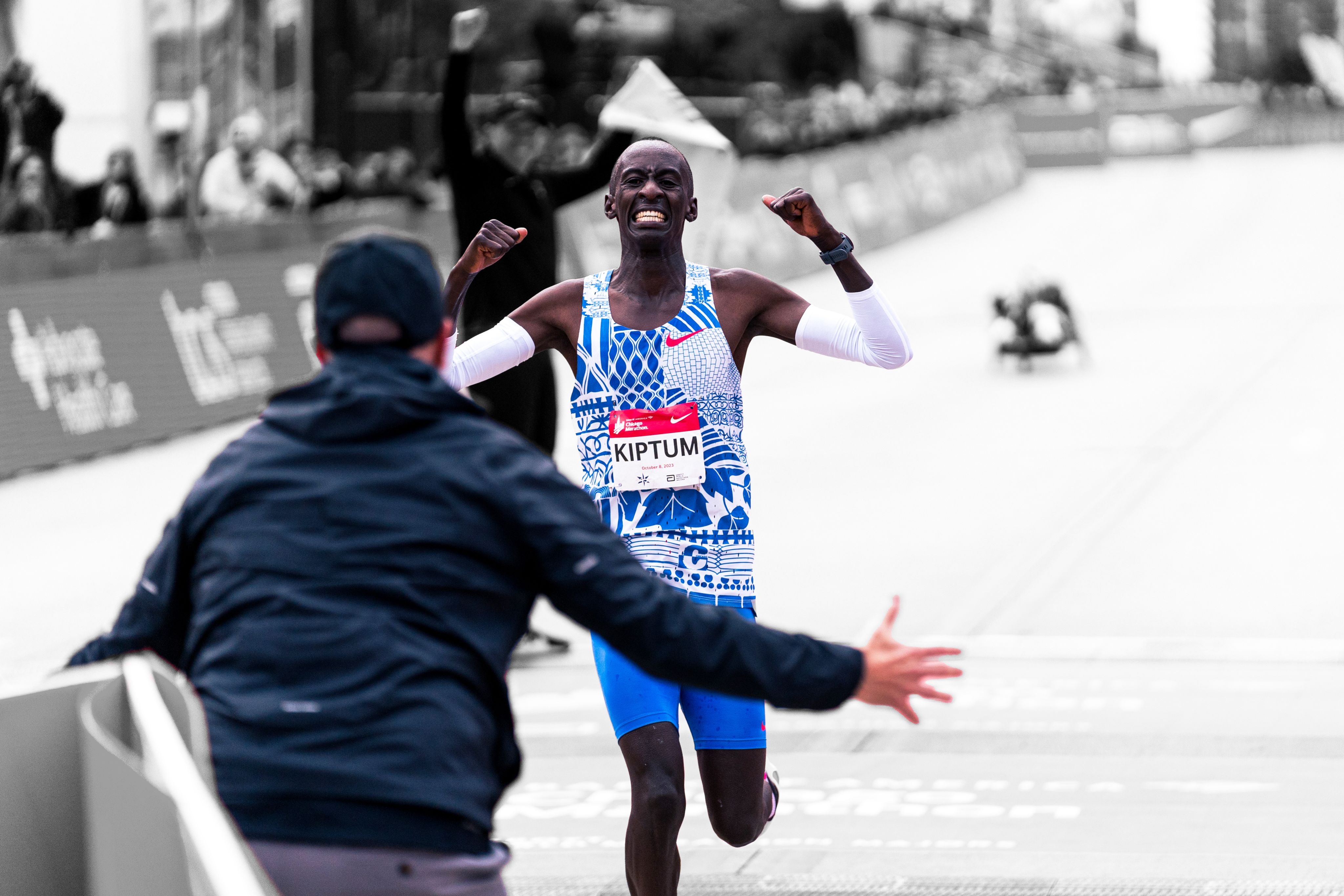
Thank you, Kelvin
MAJORS looks back at the short and shimmering marathon career of Kelvin Kiptum
Kelvin Kiptum did not so much break on to the marathon scene, as smash his way to the very top of it in a heartbeat.
His was not a name on many well-informed lips when he toed the start line of the 2022 Valencia Marathon.
This was a man who had eschewed the traditional track career pursued by so many of his forebears before transitioning to the world of big city road running.
Kiptum was a road runner from the beginning, citing a lack of funds that prevented him from travelling to track meets. It was a path less travelled, but one that seemed to suit him well.
A string of half marathons across Europe in his early years culminated in victory at the 2021 La Route du Louvre in Lens, France, and eighth place over the same distance in Valencia later that year.
2022 was his time to step up to the full distance in Valencia, but what would he do on debut in the lightning-fast surroundings of the south-eastern Spanish city known for producing quick times?
When he reached the finish, the answer was emphatic. Kiptum had become the third fastest marathon runner in history, and owner of the fastest debut time: 2:01:53.
The Abbott World Marathon Majors beckoned.
All roads lead to London four months later, where he almost snatched Eliud Kipchoge’s world record in his second attempt at 26.2 miles. The course record would have to suffice, winning in a time of 2:01:25.
But there was an overwhelming sense of inevitability that it would not be long before Kiptum would surpass Kipchoge’s 2:01:09.
Kiptum claims the world record
That feeling was confirmed in ideal conditions on the shores of Lake Michigan, where he stormed around the Bank of America Chicago Marathon to stop the clock at a scarcely-believable 2:00:35.
It was a performance that brought the prospect of the world’s first sub-two-hour marathon on a world record-eligible course tantalizingly close.
Listen to the Marathon Talk podcast tribute episode
Kiptum, who was crowned 2023 AbbottWMM champion following his win in Chicago, was due to make his sub-two bid on the streets of Rotterdam in April 2024.
He was also certain to have figured in the Olympic marathon in Paris this summer, in what could have been his first head-to-head meeting with Kipchoge.
Now, that run in the Windy City on October 8, 2023, will be the defining moment of a career and a life cut cruelly short.
As undoubted a tragedy as it is for the sport, its followers and the nation of Kenya, Kiptum’s passing will leave no one more bereft than his wife and two children. All thoughts are with them and the loved ones of his coach Gervais Hakizimana, who also tragically died in the accident.
“While he will be celebrated for his record-breaking performances, I will remember him as an incredible talent and as an even more magnificent person,” said Carey Pinkowski, Executive Race Director of the Bank of America Chicago Marathon.
“The sport of marathon running has suffered a tragic loss. Our thoughts and prayers are with his family.”
Hugh Brasher, Event Director of the TCS London Marathon added: “Kelvin had the sport of marathon running in his feet and at his feet. He was a 'once in a generation' athlete who was set to redefine the boundaries of our sport. Three marathons, three wins.
“The fastest marathon debutant in Valencia, London's course record holder and the world record holder in Chicago, all within the space of less than 12 months. His was a flame that burned so bright and last night was tragically put out.”
TAD
TALK
In his final event as race director of the Tokyo Marathon, Tad Hayano recalls how he helped start the race from the ground up and take it all the way to the Majors.
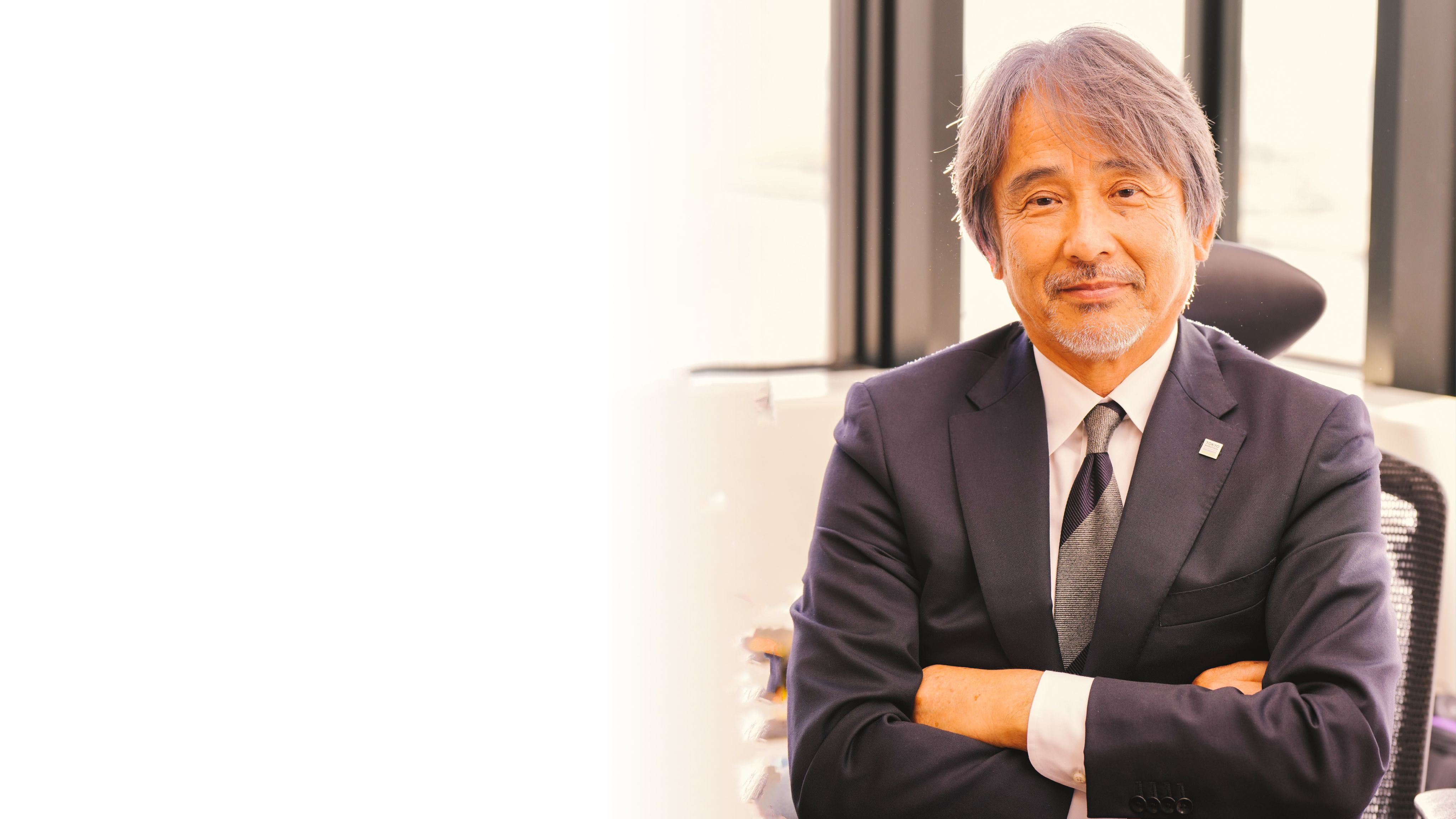
The Tokyo Marathon is the baby of the Abbott World Marathon Majors in every sense.
Having begun life in just 2007, it was then welcomed as the sixth member of the series in 2013.
More than a decade later, race director Tad Hayano will hop on to the lead motorcycle for the last time before moving into a new role with the Tokyo Marathon Foundation.
We sat down with him to go over the highlights of a fantastic journey at the helm of Japan’s brightest running jewel.
Tad, let’s start at the start. How did you become involved in the race?
I was working in marketing for one of the big shoe companies, and the idea came to me one day that Tokyo should have a citizen’s race, just like London and New York City.
I went to New York to see their race in 2001 but I didn’t know when I would be able to start. I made a presentation to the Tokyo Metropolitan Government and they loved it. This helped a lot to create the marathon we have today.
What were the challenges in getting a race off the ground?
In Japan, the elite race and the mass race were two separate ideas. I wrote a concrete idea to combine the citizen race with an elite race. It needed a city leader to make it happen. One governor, Mr. Ishihara, started thinking about it. He went with some colleagues to New York along with the Japanese Amateur Athletics Association, and they saw the economic impact and how great it was. It all combined and they opened their operations department in 2005.
I quit my job one year later and joined them in 2006. The race started one year later.
You had 30,000 runners from the start. What were the big learnings from those early events?
In Japan we are very good at copy and paste! I’m joking but once we look at something we can take it, replicate everything that’s good, see what’s wrong and right and improve very quickly. Our economy did the same thing when we looked at the US and Europe. People come to us and ask us how we developed our race. Marketing was so important, and now other races in other parts of the country are realizing that too.
When did the idea to become one of the Majors first come around?
Since we started in 2007, the governor had that kind of idea. He wanted to be like New York and London, and the Majors had just started one year before us. I talked to Dave Bedford (then race director in London) in 2010, and listened to everyone about what we needed to do. They knew we had become successful, but our elite race was of a lower standard, so we had to improve that a bit. We needed money to invite good athletes, so I expanded our marketing and we grew, so we had more money to invest in athletes. Now we have a men’s course record of 2:02:40 and a women’s course record of 2:16. I signed the Majors contract in 2012 and we became a Major from 2013.
What changed once you became a Major?
Runners’ awareness of us improved a lot. And other races became very interested. They kept asking how we did it. Gradually, everything changed, especially the number of overseas runners. This year we’ll have 14,000 from overseas in our 38,000-strong field. The number of women running has also grown, but our numbers of men versus women are not good enough yet.
In your time as race director, what has been the highlight?
We skipped 2021 because of COVID-19, and that was a real financial struggle, but we came back in 2022, (we still called it the 2021 race).
We executed the race well. The numbers were lower – we had a field of 25,000 and they were all Japanese residents only. The feeling after that was that we had survived. I almost cried when we finished. Gradually we have come back, last year we were back in profit and it seems we are expanding all over the world with runners and visitors from so many different countries.
You are well-known for riding the lead motorcycle on race day. Why do you take that role?
Under World Athletics rules, we can’t give the runners any words, it’s not allowed, so I talk to the pacemakers. I see them as our employees, they have to keep a pace that we agree in the technical meetings. I talk to important athletes like Eliud Kipchoge and ask what they think, then decide the pace, then I give the pacemakers their lecture and ask them to look at me every kilometer so I can tell them either to slow down or speed up.
Three races are bidding to join the Majors right now. You achieved it in 2012, so what advice do you have for them?
My suggestion is to make sure you keep your originality compared to the other six. All six do different things and that’s OK. London has its huge charity component, Boston’s originality is that it’s the longest-running. Berlin is known for its fast course and in Tokyo we have a fusion of the old and the new.
As a base, we have to make sure we have safe races, offer up a great experience and excitement and diversity among our runners, but then we must create other elements that make us different.
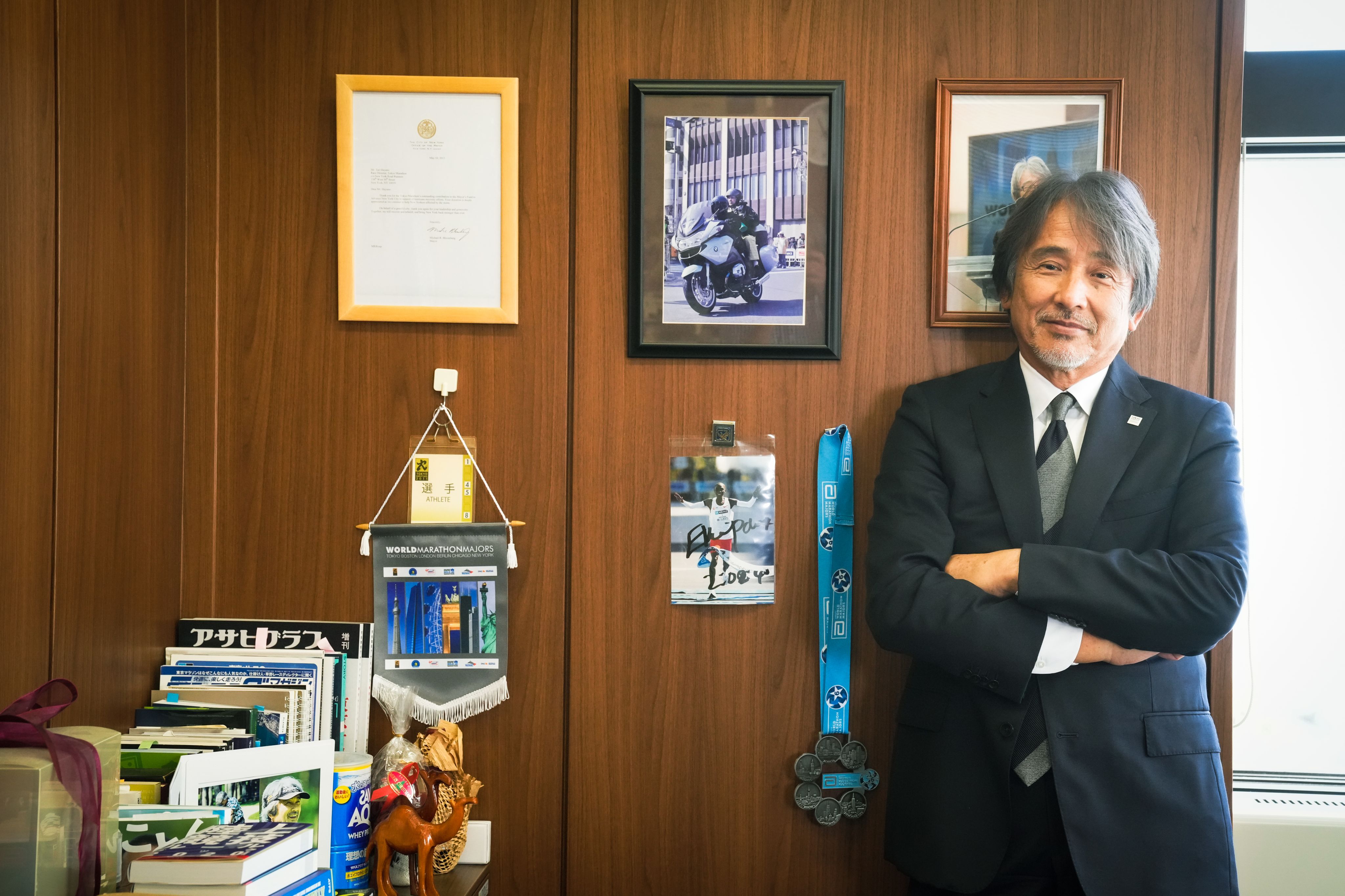
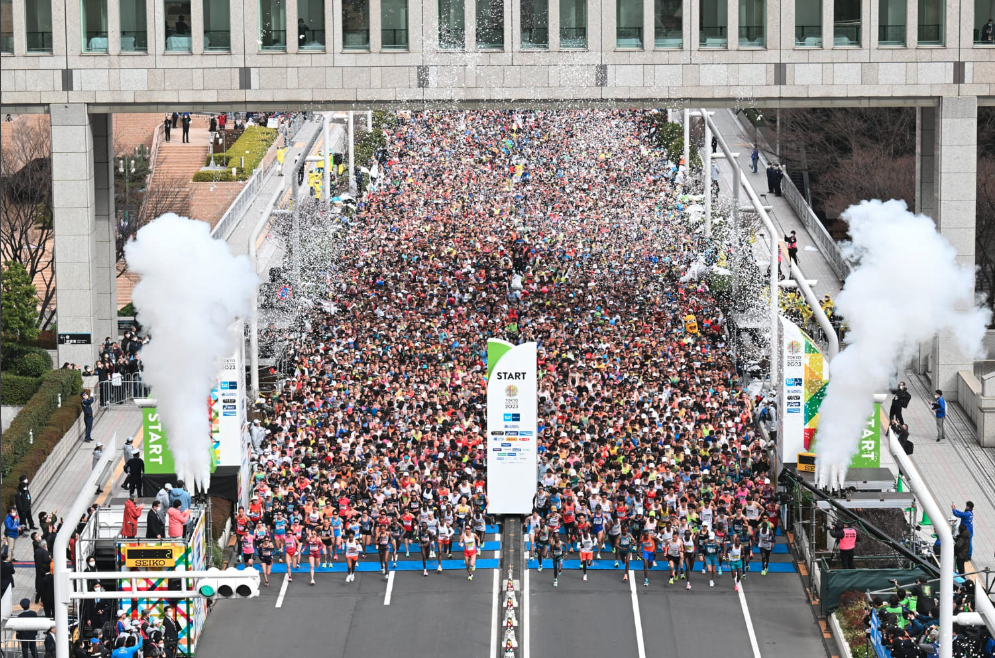
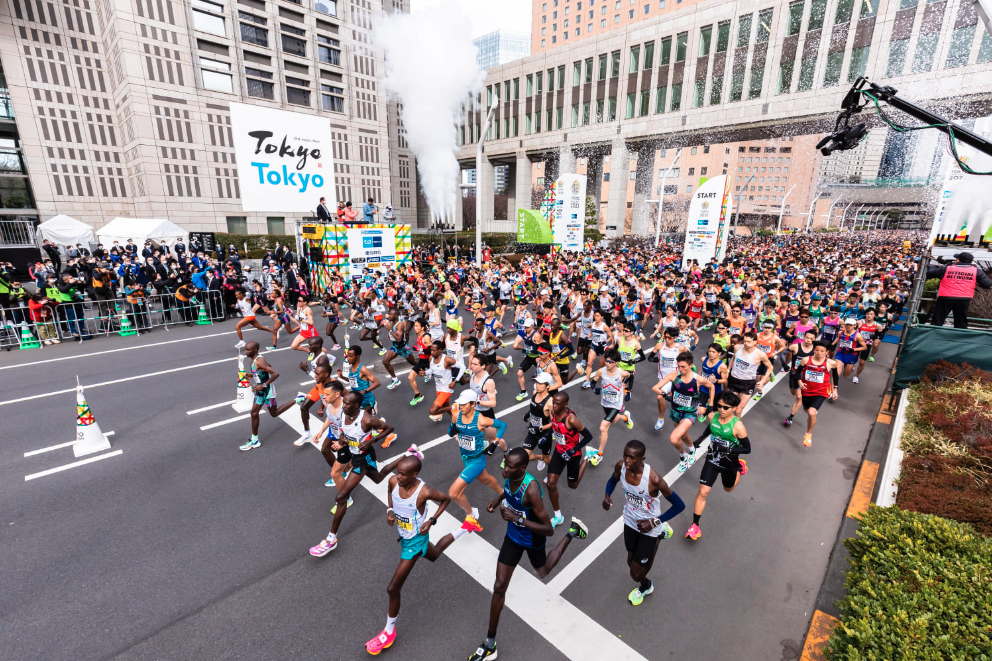
THE
COMEBACK
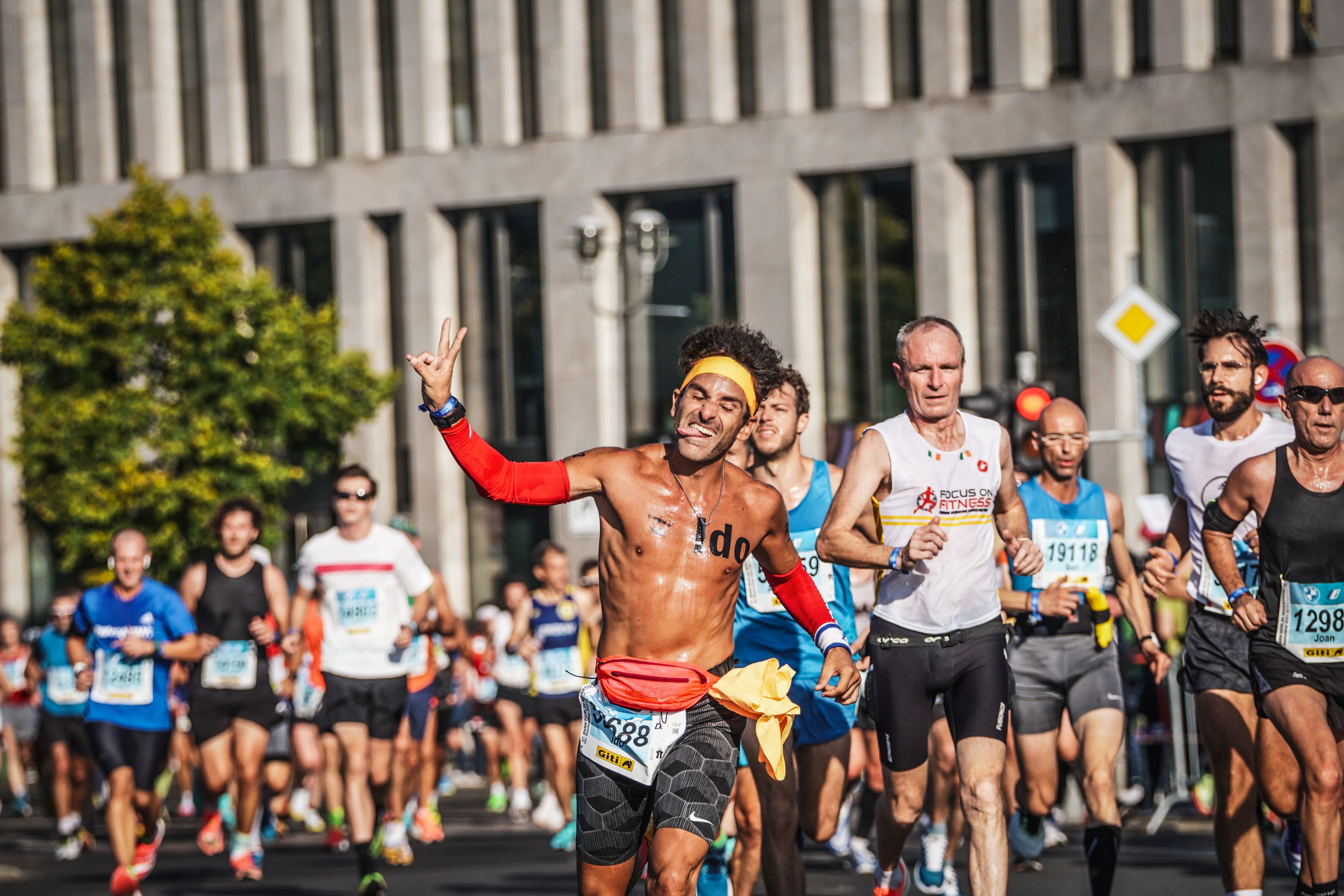
THE
COMEBACK

Ido Simyoni did not let a life-threatening tumor stop his quest for the Six Star medal, but he then faced another huge challenge to recover from major surgery. This is his story.
Words: Danny Coyle
Ido Simyoni was 14 years old when he felt the lump above his eye for the first time.
“I told my mom, ‘I feel like I have something here that I don't have on this side’, and my mom was like, ‘just go to the doctor on your own’,” he recalls.
What followed was an X-ray, a visit to the eye clinic, a conversation between the doctors and his parents at last and then the operation to remove a tumor that he was told could have claimed the sight in his left eye.
The cause? “I discovered that I have fibrous dysplasia. It's very rare. It's not genetics, I didn't get it from my mom, I didn't get it from my dad. I actually got it while I was developing in the womb.”
The condition is caused by a chromosomal mutation that causes tumors, rather than bone, to grow in teenagers. It can occur in other parts of the body, but the skull is the most complicated area to treat.
“I remember as a child when the doctors tried to explain to me what it is, they said to imagine a tree and that something is starting to eat the tree. That's what happens to you, that tumor is basically eating the bone, and so they have to take off the area all around the bone.”
Although successful, one year later, Ido felt something growing again. “And you could see it,” he says. “There was something coming out, which was shocking, really growing.”
A second 16-hour surgery followed at the age of 17.
“They removed everything,” he says. “And then they told me, ‘this is the last time you're going to see us’, because fibrous dysplasia basically grows when you're a child. They thought they had taken a safe margin and that I was going to be fine.”
Nine years later, the headaches began once more.
“You couldn't see it, but I started feeling it from the inside, like a big pressure.”
Ido returned to the operating theatre.
Going in through an incision that arced across the top of his head from ear to ear, the surgeons discovered that the tumor was, indeed, back again. This time, although still on the skull, it was very close to the brain.
“It tore the dura mater, which is what protects our brain. It tore it and started getting into the brain. And that's exactly the pressure that I had been feeling.”
The doctors again told him that this time was the last time. “I believed them because when I was 26, the internet was more developed. I was able to do my research to learn more about fibrous dysplasia or to learn about patients with fibrous dysplasia, to understand who is similar to me who is going through that journey with me.”
And for more than 10 years, that faith held firm. No follow-ups, no pain and a new life in London, where he moved in 2013 from his native Israel. There, he began to fall in love with running, and completed his first two Abbott World Marathon Majors.
As January 2022 dawned, and now living in New York, he was planning the completion of his Six Star journey. But those plans were about to be ripped up.
“I started feeling bad again,” he says. “I felt like something was inside, but it didn't feel like the same tumor, it was a different pain. And then one day I woke up very swollen.”
The cause was the previous surgery he had undergone in his twenties. The bone taken from elsewhere on his skull – to cover the void at the front – was no longer big enough. In the space around it, another tumor was growing.
“The bone shrank, and stuff got stuck there in my sinuses and behind it. And it created a new tumor – more like a cyst that was really building pressure again, and tore my dura again. So my brain was exposed again.”
He went to the doctor who immediately recommended surgery. The answer from his patient was not what he was expecting.
“’Look, there is this challenge that I'm doing, I need to finish it’”, Ido told them.
“I needed to run, because I didn't know if I was ever going be able to run again. I knew that I had Chicago booked in October, but then I also had Tokyo, Boston and London to go.”
He found a quick race in the States and earned his BQ and was able to enter Tokyo using a charity place deferred from the COVID-hit 2020 event.
“I asked the doctor if we could postpone surgery by nine months. He said to me, ‘look, it's not urgent, but if it becomes urgent, you will have to come in.'”
Two weeks before Tokyo, Ido developed cerebral edema – a swelling of the brain. Going against doctor’s recommendations, he took the risk to travel.
“I did take a big risk. But the marathon actually went very well and I ran a PR. In the last two miles, I started feeling very bad and I had to slow down. For the first time in my life I threw up after a run.”
The following month, he ran Boston and London, receiving his Six Star medal from AbbottWMM Six Star program lead Judee Kakos.
“She was there in such an important moment for me. I just wanted to hug her. I didn't know if I would be able to run again after the surgery, so London could have been my last marathon and she was there. She's that person that you connect with every single time as you're progressing on your journey, and she’s so supportive.”
On May 12 last year, Ido went in for his surgery to remove the old mesh plate, the cyst, and to close the opening to his brain. For the next three months he walked around without a forehead, injecting himself with antibiotics to keep the hole in his skull clean before the second surgery in August.
“I really liked the doctor that I found,” he says. “He understood that I was going to be running again and put the right material in to protect me. The ideal recovery from a surgery like this for all the scar tissue to heal is a year, but he said: ‘your body will tell you if you can run or not’.”
He ran the Abbott International 5k on Chicago race that October.
“It was awful, probably one of the worst races I ever had, and I threw up again. I just burst into tears. I am a sub-three-hour marathon runner and I couldn’t even run a 5k.
“I waited for two or three more weeks, and I officially got back to running in November. I think my body in October was just not ready to run."
It was then that he decided to set his next challenge: completing all six Majors in one year. He begins with Tokyo on March 3.
Preparations have gone well, including a training camp in Iten, Kenya, but speed will not be his priority, at least in the spring.
“It's not going to be for time, it's going to be to show myself that I can. And it's going to be to show others that even when you're at the bottom, or even when you're down, even when science and medicine are telling you that you can’t, when you really want it, you can get it.
“I don't know what's going to happen. Hopefully, when I get to Berlin, Chicago and New York, I'll be faster. But the first three marathons that I'm going to do, I'm just going to try to enjoy it. Almost a year ago I was there crying at the finish line wondering if I was going to be able to run again. And here I am.”
If your 2024 plans have not been firmed up yet, the world is your oyster when it comes to seeking a fast time for 2025 AbbottWMM Age group World Championship qualification.
Zurich Barcelona Marathon, March 10
It's happening soon, but if you're in shape and looking for a marathon experience in one of the great European destinations, Barcelona is a fantastic option.
A new course that takes in all the iconic sights of this famous city has been designed to give runners a true tour of the Catalan capital.
Islandsbanki Reykjavik Marathon, August 25
The marathon passes through downtown Reykjavik, a residential area, landmarks, rivers, and along the coastline offering stunning views of the surrounding ocean and mountains.
It's a fantastic way to explore the city, get a taste of Iceland's unique landscapes, and immerse yourself in the local running culture.
The marathon also usually attracts around 1,500 runners, so the chance to enjoy some space may be a welcome change for those of you used to the crowds of a big city race.
Baxters Loch Ness Marathon, September 29
The scenic beauty of Loch Ness accompanies you for much of this course as you run towards the finish in Inverness, the capital city of the Scottish Highlands.
There are some hills to negotiate before you make it, but the calm, picturesque setting for this run help to offset the tough climbs when they come.
For those hunting a qualifying time for Boston, St George prides itself on being among the top 10 BQ races on the list.
That means it may also serve you well in the hunt for a qualifying time for the 2025 Age Group World Champs.
You'll descend through some stunning Utah mountain scenery as you chase that time in what will be the 47th running of a much-loved and well-regarded event.
Kosice Peace Marathon, October 6
It will be the 100-year anniversary of this race in 2024, which means there is possibly no better time to put this on your list. The race was inspired by the 1924 Paris Olympics, so it would be a fitting year to celebrate its century in the same year as the Games return to the French capital.
A race that began all those years ago with eight men now boasts an international field of 10,000 in this east-Slovakian city, and a history that is a great source of pride to organizers and citizens of the city alike.
Techcombank Ho Chi Minh City International Marathon, December 5
The streets of one of the world’s most vibrant cities belong to its marathon runners for a day in what has become one of the most iconic races in Southeast Asia. The course passes numerous historic landmarks, before finishing with vantage points to view the spectacular city skyline as your backdrop.
There are over 375 qualifying races in the 2024 AbbottWMM Wanda Age Group World Rankings. Find out more at worldmarathonmajors.com/rankings
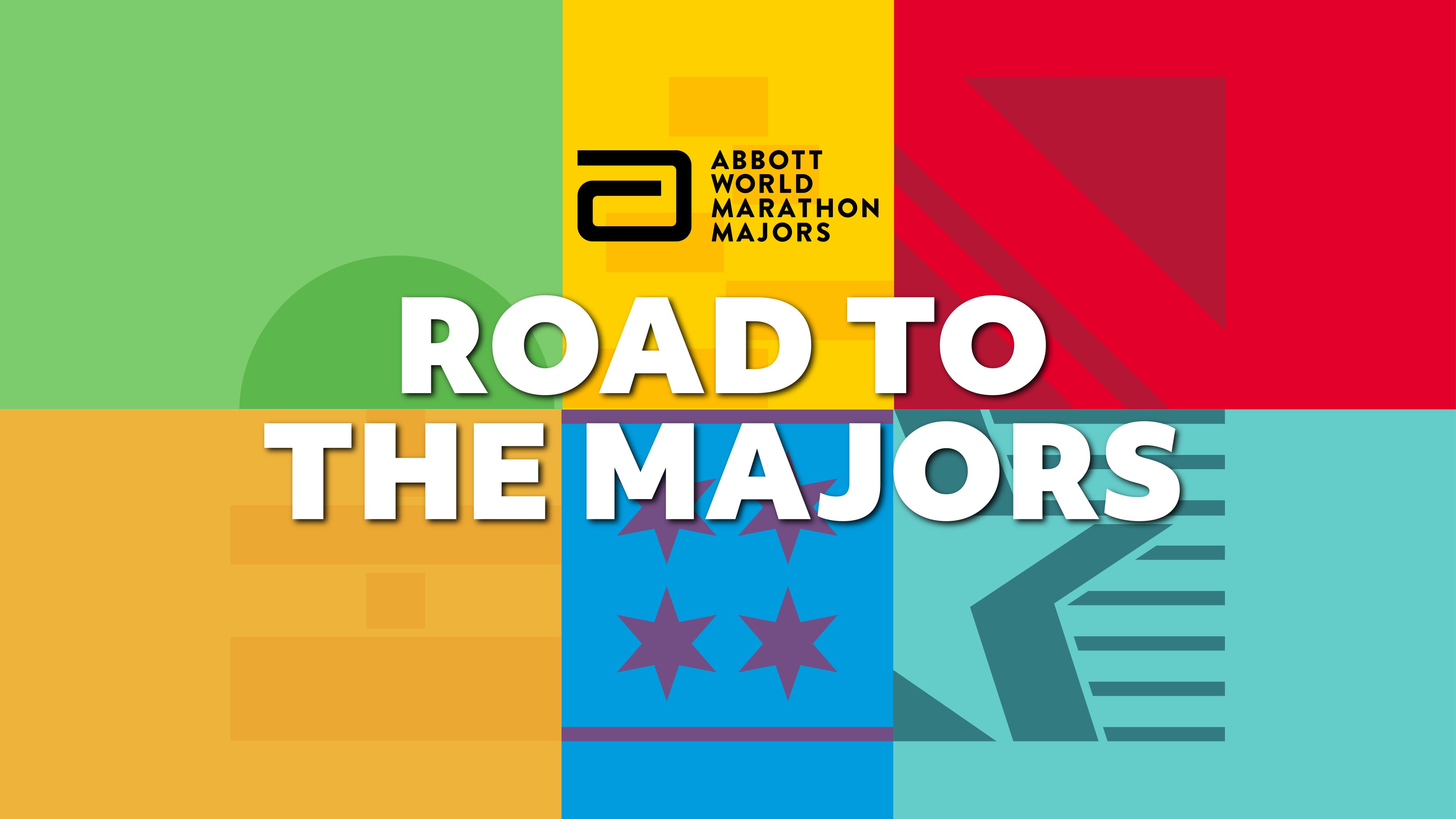
Lace up for the Road to the Majors
The virtual half marathon series returns for 2024
In 2023 the AbbottWMM Global Run Club launched a new series of events for members to boost their chances of earning a spot in one of the Majors.
The Road to the Majors half marathon program earns every participant an extra place in one of our race draws for a star you still need to continue or complete your Six Star journey.
Last year, a staggering number of Road to the Majors finishers went on to be successful in our draws thanks to the extra slots they secured by finishing one or more of our virtual half marathons in the series.
For more information, visit globalrunclub.com
Fuel for thought
Our partners at Abbott have put together the optimal approach you could take to get your training nutrition dialed in
Running a marathon puts a major strain on the body, and, unfortunately, many runners don't focus enough on their diets.
Maintaining a healthy training diet can maximize your performance and make it much easier to eventually cross that finish line. Here's what you need to know about preparing to run 26.2 miles, from the foods to focus on to the best approach for race-day nutrition.
A Healthy Diet for Marathoners
The first step is making sure you are getting enough calories to support the increase in activity. Increasing physical activity without fueling the body correctly can lead to muscle loss, increased risk for illness, stress and poor sleep.
If you're doing moderate levels of intense training — for example, training two to three hours per day, five to six days a week — a 110–220-pound (50-100 kg) athlete could need to consume 2,000–7,000 calories per day in order to support that amount of activity, according to the International Society of Sports Nutrition (ISSN). To meet those elevated caloric needs, you will likely want to eat three meals and multiple snacks each day.
It's also a good idea to choose nutrient-dense food while training. You will not perform your best on a diet of soda and donuts, even though junk food may make it easy to meet your calorie goals. A marathon training diet should be well-balanced and include adequate amounts of whole grains, fruits, vegetables, lean protein and healthy fats.
Leveraging Macronutrients
Macronutrients (i.e., carbohydrates, proteins and fats) are all potential sources of energy for the body, but the body prefers to rely on carbohydrates and fats. As a result, highly active individuals and athletes typically have higher needs for carbohydrates and fats compared with less active people.
When designing your marathon training diet, the most important macronutrients to focus on are carbohydrates, which provide your body with the fuel it needs to reach the finish line. According to the ISSN, athletes following intense training schedules need to eat between 5–8 grams per kg of carbohydrates per day.
Protein is also an important macronutrient for marathon runners. The ISSN recommends an intake of 1.4–1.8 grams per kg per day. Protein, which will help with recovery, injury prevention and support lean muscle, should be consumed throughout the day and always after a run.
Fat should also be part of a healthy marathon runner diet. The ISSN recommends keeping fat at around 30% of total calories, but this can be increased to meet calorie needs if necessary.
Building Your Marathon Training Diet
When you're preparing for a marathon, you don't want to just focus on creating a training plan for running; you also want a solid nutrition plan. Start by determining how much you will be running and then calculate your caloric needs.
If you won't be running more than two hours a day, you won't need to increase your calories that much. The important thing is to listen to your body. If you're hungry, you should eat. If you feel sluggish during a run, try to figure out why. Maybe you're not eating enough, or you're choosing the wrong foods.
Next, create a meal plan around your training schedule. Meals should be balanced and include whole grains, protein, fat, fruits and vegetables. Meal timing matters as well. You should eat a full meal about three to four hours before your run.
It's also wise to consume a small snack of carbohydrates and protein one to two hours before your workout. After your run, eat a meal high in protein and carbohydrates within 45 minutes to help muscles recover.
Maximizing Nutrition Every Morning, Noon and Night
Ready to start planning your next shopping trip? Here's a sample marathon training diet plan that can help you reach your goals:
• Breakfast: Eggs, whole wheat toast, half an avocado and a whole banana
• Morning snack: Apple with peanut butter
• Lunch: Quinoa bowl with black beans, chicken, assorted vegetables, salsa and cheese
• Pre-run snack: Greek yogurt with berries and low-fat granola
• Post-run dinner: Salmon, brown rice, broccoli with butter
• Bedtime snack: Milk, whole-grain cereal and berries
Optimizing Race-Day Nutrition
Figuring out proper nutrition on race day is the crucial final step in preparing your marathon training plan. Choosing the wrong foods or trying to mix up your routine can negatively impact your performance.
To avoid this, make a race-day plan ahead of time. Try packing everything you need a few days before so you don't forget anything important. Lastly, focus on hydration, fast-acting carbs and getting enough calories to support running 26.2 miles all at once.
Following a solid nutrition plan while training and on race day will help make running easier, allowing you to achieve all your marathon goals this year as well as in the future. For more tips on developing the best meal plan for you, a registered dietitian can help.

BERLIN, SEPTEMBER 28, 2014
A MAJOR MOMENT
The pre-Eliud Kipchoge era saw the world record gradually lower in the early 2000s.
Luminaries such as Haile Gebrselassie and Wilson Kipsang chipped away at a mark that now seems like it belonged to another sport.
For a long time, Berlin seemed the only place where the record could be set, with the time being re-written on six occasions in the 11 years before the 2014 edition of the race.
This would be the year it was taken through a new barrier by the talented, enigmatic Dennis Kimetto.
Kimetto had set a new course record in Chicago the previous year of 2:03:45, and was on an astonishing trajectory having only ran his first 26.2-mile race in 2012. That was also in Berlin, where he recorded the-then fastest marathon debut ever seen, with a time of 2:04:16.
In 2013, he won the Tokyo and Boston crowns, underlining his dominance in the early part of the century's second decade.
In 2014, on a perfect day in the German capital, Kimetto became the first man to break the 2:03 barrier when he clocked 2:02:57 to win the race.
His performance shattered the record – held for just a year by Kipsang – by 26 seconds, and was so fast that the man who came in behind him, Emmanuel Mutai, also broke the old record.
Kimetto ran a negative split with a first half of 1:01:45 and a second stanza of 1:01:02, and his run immediately set tongues wagging about the prospect of the two-hour barrier being broken one day.
It turned out that it would be his last victory in a Major, and it would be a decade until we truly believed that magic mark was within someone’s grasp.
